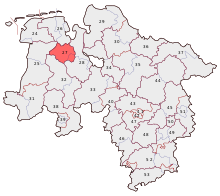Oldenburg – Ammerland
Oldenburg – Ammerland is one of the 299 single member constituencies used for the German parliament, the Bundestag. The constituency elects one representative under the mixed member proportional representation (MMP) system. Under the current constituency numbering system, it is designated as constituency 27.[1]
| 27 Oldenburg – Ammerland | |
|---|---|
| electoral district for the Bundestag | |
 | |
| State | Lower Saxony |
| Country | Germany |
| Current electoral district | |
| Created | 1949 |
| Party | SPD |
| Current Member | Dennis Rohde |
| Elected Year | 2017 |
| Most Successful Party | SPD (13 times) |
The constituency was created for the 1949 election, the first election in West Germany after World War II. After wins for the Free Democratic Party (FDP) and the Christian Democratic Union (CDU) in the early elections, it was gained by the Social Democratic Party (SPD) at the 1969 election and held it until the 2005 election. At the 2009 election, the CDU candidate gained the constituency. In 2013, it was regained by the SPD.
Overview
Located in Lower Saxony, the constituency consists of the independent cities of Oldenburg and Ammerland.[2]
History
Upon creation for the 1949 election, the district was called Oldenburg with constituency number 8.[3]
| Election | Constituency No. | Constituency Name |
|---|---|---|
| 1949 | 8 | Oldenburg |
| 1953-61 | 30 | |
| 1965-76 | 22 | |
| 1980-98 | Oldenburg – Ammerland | |
| 2002-09 | 28 | |
| 2013 | 27 |
Members of the Bundestag
| Election | Member | Vote share % | Party | Source | Note | |
|---|---|---|---|---|---|---|
| 1949 | Robert Dannemann | 24.8 | Free Democratic Party | [3] | 1st election after the division of the country | |
| 1953 | 56.5 | [3] | Dannemann was the common candidate of the CDU-FDP-DP alliance[4] | |||
| 1957 | Wilhelm Nieberg | 35.9 | Christian Democratic Union of Germany | [3] | ||
| 1961 | 34.9 | [3] | ||||
| 1965 | Heinz Frieler | 38.2 | [3] | |||
| 1969 | Kurt Ross | 42.9 | Social Democratic Party of Germany | [3] | ||
| 1972 | Walter Polkehn | 52.9 | [3] | |||
| 1976 | 47.7 | [3] | ||||
| 1980 | 48.8 | [3] | ||||
| 1983 | 45.0 | [3] | ||||
| 1987 | Dietmar Schütz | 45.1 | [3] | |||
| 1990 | 43.6 | [3] | 1st election of the re-united Germany | |||
| 1994 | 46.5 | [3] | ||||
| 1998 | 51.5 | [3] | ||||
| 2002 | Gesine Multhaupt | 47.1 | [3] | |||
| 2005 | 44.7 | [5] | ||||
| 2009 | Thomas Kossendey | 35.5 | Christian Democratic Union of Germany | [6] | ||
| 2013 | Dennis Rohde | 37.4 | Social Democratic Party of Germany | [7] | ||
| 2017 | 36.3 | [8] | ||||
References
- Officer, The Federal Returning. "Results Oldenburg – Ammerland - The Federal Returning Officer". www.bundeswahlleiter.de. Retrieved 2018-02-06.
- Officer, The Federal Returning. "Delimitation of constituency boundaries Oldenburg – Ammerland - The Federal Returning Officer". www.bundeswahlleiter.de. Retrieved 2018-02-06.
- Vierhaus, Rudolf (2002-01-01). Biographisches Handbuch der Mitglieder des Deutschen Bundestages 1949-2002 (in German). Walter de Gruyter. ISBN 9783110969054.
- 2018-01-26, Deutsche Welle. "Germany: Angela Merkel's conservatives and SPD open grand coalition talks". DW.COM. Retrieved 2018-02-06.CS1 maint: numeric names: authors list (link)
- "NIEDERSACHSEN BUNDESTAG ELECTIONS 2005 September 18 GERMANY ELECTIONS ARCHIVE". www.todor66.com. Archived from the original on 2006-06-21. Retrieved 2018-02-04.
- "Endgültiges Ergebnis - Landeswahlleiter Niedersachsen" (PDF). landeswahlleiter.niedersachsen.de. Retrieved 2018-02-05.
- Officer, The Federal Returning. "Elected candidates by Land lists in Lower Saxony - The Federal Returning Officer". www.bundeswahlleiter.de. Retrieved 2018-02-04.
- Officer, The Federal Returning. "Elected candidates by Land lists in Niedersachsen - The Federal Returning Officer". www.bundeswahlleiter.de. Retrieved 2018-02-04.